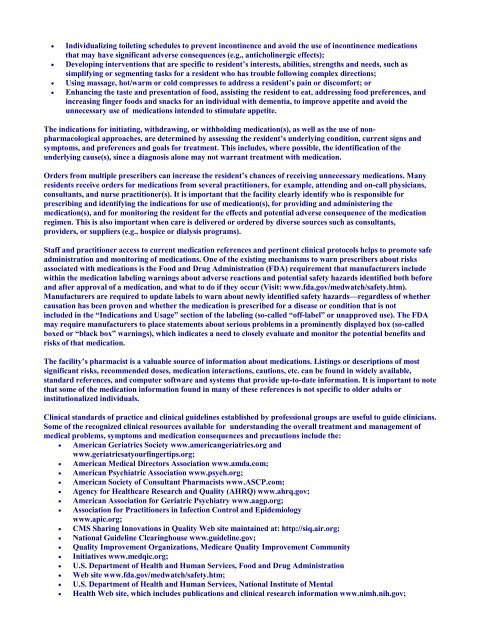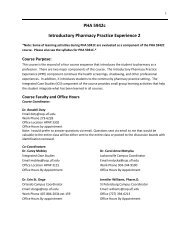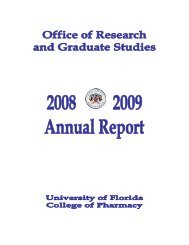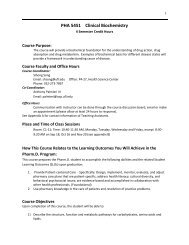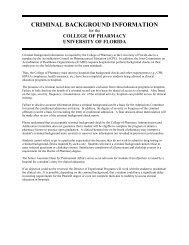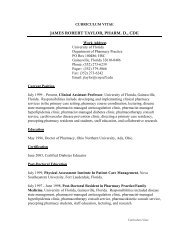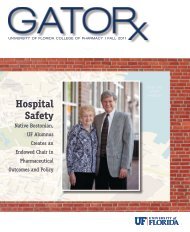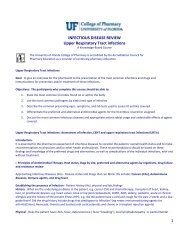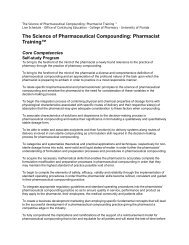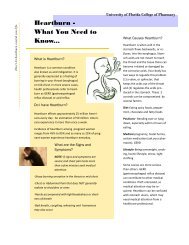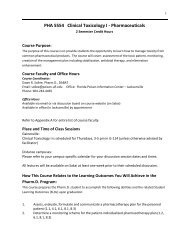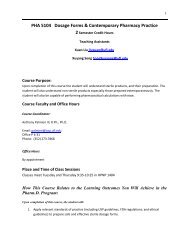Module 3: The Drug Regimen Review - College of Pharmacy ...
Module 3: The Drug Regimen Review - College of Pharmacy ...
Module 3: The Drug Regimen Review - College of Pharmacy ...
You also want an ePaper? Increase the reach of your titles
YUMPU automatically turns print PDFs into web optimized ePapers that Google loves.
• Individualizing toileting schedules to prevent incontinence and avoid the use <strong>of</strong> incontinence medications<br />
that may have significant adverse consequences (e.g., anticholinergic effects);<br />
• Developing interventions that are specific to resident’s interests, abilities, strengths and needs, such as<br />
simplifying or segmenting tasks for a resident who has trouble following complex directions;<br />
• Using massage, hot/warm or cold compresses to address a resident’s pain or discomfort; or<br />
• Enhancing the taste and presentation <strong>of</strong> food, assisting the resident to eat, addressing food preferences, and<br />
increasing finger foods and snacks for an individual with dementia, to improve appetite and avoid the<br />
unnecessary use <strong>of</strong> medications intended to stimulate appetite.<br />
<strong>The</strong> indications for initiating, withdrawing, or withholding medication(s), as well as the use <strong>of</strong> nonpharmacological<br />
approaches, are determined by assessing the resident’s underlying condition, current signs and<br />
symptoms, and preferences and goals for treatment. This includes, where possible, the identification <strong>of</strong> the<br />
underlying cause(s), since a diagnosis alone may not warrant treatment with medication.<br />
Orders from multiple prescribers can increase the resident’s chances <strong>of</strong> receiving unnecessary medications. Many<br />
residents receive orders for medications from several practitioners, for example, attending and on-call physicians,<br />
consultants, and nurse practitioner(s). It is important that the facility clearly identify who is responsible for<br />
prescribing and identifying the indications for use <strong>of</strong> medication(s), for providing and administering the<br />
medication(s), and for monitoring the resident for the effects and potential adverse consequence <strong>of</strong> the medication<br />
regimen. This is also important when care is delivered or ordered by diverse sources such as consultants,<br />
providers, or suppliers (e.g., hospice or dialysis programs).<br />
Staff and practitioner access to current medication references and pertinent clinical protocols helps to promote safe<br />
administration and monitoring <strong>of</strong> medications. One <strong>of</strong> the existing mechanisms to warn prescribers about risks<br />
associated with medications is the Food and <strong>Drug</strong> Administration (FDA) requirement that manufacturers include<br />
within the medication labeling warnings about adverse reactions and potential safety hazards identified both before<br />
and after approval <strong>of</strong> a medication, and what to do if they occur (Visit: www.fda.gov/medwatch/safety.htm).<br />
Manufacturers are required to update labels to warn about newly identified safety hazards—regardless <strong>of</strong> whether<br />
causation has been proven and whether the medication is prescribed for a disease or condition that is not<br />
included in the “Indications and Usage” section <strong>of</strong> the labeling (so-called “<strong>of</strong>f-label” or unapproved use). <strong>The</strong> FDA<br />
may require manufacturers to place statements about serious problems in a prominently displayed box (so-called<br />
boxed or “black box” warnings), which indicates a need to closely evaluate and monitor the potential benefits and<br />
risks <strong>of</strong> that medication.<br />
<strong>The</strong> facility’s pharmacist is a valuable source <strong>of</strong> information about medications. Listings or descriptions <strong>of</strong> most<br />
significant risks, recommended doses, medication interactions, cautions, etc. can be found in widely available,<br />
standard references, and computer s<strong>of</strong>tware and systems that provide up-to-date information. It is important to note<br />
that some <strong>of</strong> the medication information found in many <strong>of</strong> these references is not specific to older adults or<br />
institutionalized individuals.<br />
Clinical standards <strong>of</strong> practice and clinical guidelines established by pr<strong>of</strong>essional groups are useful to guide clinicians.<br />
Some <strong>of</strong> the recognized clinical resources available for understanding the overall treatment and management <strong>of</strong><br />
medical problems, symptoms and medication consequences and precautions include the:<br />
• American Geriatrics Society www.americangeriatrics.org and<br />
www.geriatricsatyourfingertips.org;<br />
• American Medical Directors Association www.amda.com;<br />
• American Psychiatric Association www.psych.org;<br />
• American Society <strong>of</strong> Consultant Pharmacists www.ASCP.com;<br />
• Agency for Healthcare Research and Quality (AHRQ) www.ahrq.gov;<br />
• American Association for Geriatric Psychiatry www.aagp.org;<br />
• Association for Practitioners in Infection Control and Epidemiology<br />
www.apic.org;<br />
• CMS Sharing Innovations in Quality Web site maintained at: http://siq.air.org;<br />
• National Guideline Clearinghouse www.guideline.gov;<br />
• Quality Improvement Organizations, Medicare Quality Improvement Community<br />
• Initiatives www.medqic.org;<br />
• U.S. Department <strong>of</strong> Health and Human Services, Food and <strong>Drug</strong> Administration<br />
• Web site www.fda.gov/medwatch/safety.htm;<br />
• U.S. Department <strong>of</strong> Health and Human Services, National Institute <strong>of</strong> Mental<br />
• Health Web site, which includes publications and clinical research information www.nimh.nih.gov;


